Archive for October 7, 2009
Gossip Girl thoughts
October 7, 2009* The Masters of the Universe Society? Oh, indeed. I don’t even care that it’s kind of a cheap shot at nerds, or that He-Man’s a reference that people in the Gossip Girl writers’ age group are a lot more likely to make than people in the Gossip Girl characters’ age group. “The madness and genius of Skeletor. That is correct–I said genius.” Indeed. Indeed.
* Just how many cast members did Hilary Duff coincidentally bump into during the course of this episode, anyway? Small island!
* Wow, they’ve gone to the “character with a secret identity” well twice so far this season. And they’ve done it before with the British aristocrat last season, and Georgina, and that dude who grifted with Poppy. I’m starting to wonder if aliases really are this common among the upper crust.
* Still, I’m appreciating how much better they’re doing at introducing new semi-permanent cast members into the mix. Haha, remember that artist last season? Carter, Georgina, Nate’s girlfriend, the Duffster, and even Brother Scott all put that clown to shame. I feel like you could go interesting places with any of them. I still don’t understand why they haven’t made Serena’s brother into a main-main character by now, though.
* Did anyone catch what motivated Jenny to start exercising her divine right of queens at the end? Was it just because she was pissed at Blair for stepping in? At any rate it seemed pretty obvious, as it should have been to Jenny, that publicly abdicating the throne would lead to a power vacuum someone would rush to fill. She should have set herself up as a benevolent dictator all along.
* I really enjoyed watching Nate trick Dan by encouraging him to ask Duff out, then laughing about it under his breath, simply because it was new. When was the last time Nate got to do something that wasn’t an on-again off-again romance or rebelling against his family? It was just a pleasure to get to see him do something different. Chase Crawford gets the short end of the stick because Nate is pretty much just the “Not Chuck or Dan” character. I’d love to see him fleshed out some more.
* Tyra Banks? As a character? ThaFUCK? Just when I had successfully weaned myself off of America’s Next Top Model! Okay, maybe I’m just a little upset at the dropped ball that was showing her and Serena after a sleepover night and not having them wake up in bed together. Okay, maybe a lot upset.
* “So, Jenny, we’re cool with the whole sexual-assault thing now?” “Totally, Chuck. These things happen!” Part of me is still pulling for a Comedian/Silk Spectre I-style post-sexcrime romance.
* As the Missus put it: “Jesus, Serena, why even bother wearing a skirt?” Seconded!
* Chuck, and Ed Westwick, just gets more and more magnificent with each passing episode. Chuck Bass is the Sol Tigh, the Omar Little, the Al Swearengen of Gossip Girl. Amy and I will hit the little rewind button on the TiVo remote and simply rewatch him turn his head or arch his eyebrow and just laugh and laugh with delight. And holy shit, Chuck’s speech to Blair at the end was amaaaaaaAAAAAAAAaaaaazing. What a fucking stroke of genius for Chuck, like God, to take Blair’s despair as a sin against him! Dammit, Blair Waldorf–if you can make it with Chuck Bass, you can make it anywhere!
Carnival of souls
October 6, 2009* Today at Robot 6, I showed off and ran down my SPX haul. Beautiful, isn’t it?
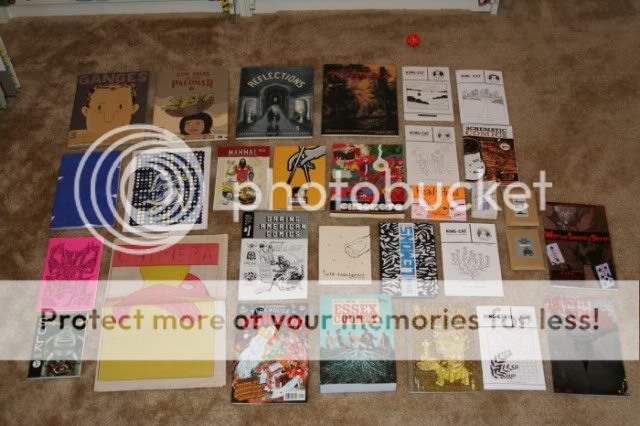
* A threesome on Gossip Girl? Pray for MMF, people!!! (Via Jason Adams.)
* Grant Morrison and Sean Murphy’s Joe the Barbarian has been expanded to eight issues. This looks to be very, very pretty, and given Morrison’s heretofore unabashed embrace of heroic fantasy as a means of uplift, its “tween’s toys come to life in a fantasy world” plot could get interesting, presuming Morrison’s approach goes beyond “hey, that’s awesome!”
* You saw ’em there first: Fantagraphics previews its Previews listings for January 2010.
* My Robot 6 confrere Chris Mautner reviews R. Crumb’s Book of Genesis. Sounds like it’s notable for its un-Crumb-ness in large part.
* Oh hey, pictures from Neil Marshall’s Centurion! With all the movies I’ve dropped the ball on lately, I’ll be damned if I whiff on this one.
* Artist L. Nichols presents block-printed portraits of He-Man and She-Ra. They have the power.
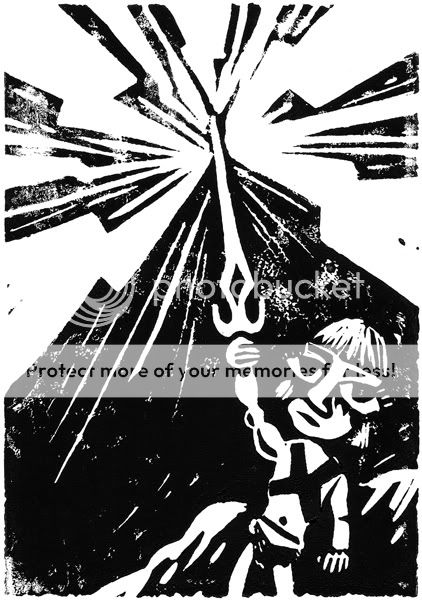
* Real-Life Horror: The government appears to have neglected to destroy tapes of the interrogation of detainee Mohammed al Qahtani. Of course, the only things more depressing than the videotaped spectacle of a man being tortured at the hands of American agents will be the Obama Administration’s Bush-like attempts to suppress its release, and the full-throated endorsement of the videotaped behavior by conservatives should those attempts fail.
* On a cheerier note, Who doesn’t love sentient plants?
Comics Time: Cold Heat Special #7
October 5, 2009
Cold Heat Special #7
Michael DeForge, writer/artist
PictureBox, September 2009
12 pages
I don’t remember how much it cost
Browse the Cold Heat shop, where it’ll probably end up eventually
Band logos are an interesting thing, and when they succeed at visually representing a band’s musical and aesthetic project, a pretty awesome thing. Which makes a lot of old-school heavy metal logos a baffling thing–instead of offering a clear, brandable distillation of the band, they’re often illegible to the point of incomprehensibility. (Spend some time on Obsidian Obelisk and you’ll see what I mean.) I suppose this is a tip of the hat to the uncommercial, underground nature of much of that music–it’s so not for you that the masses can’t even make out the band name. (“Songs for the deaf–you can’t even hear ’em!”) My favorite recent example of this aesthetic cropping up in comics is Rinzen’s title design for Paul Pope’s Batman Year 100, which combines past stabs at shaping the word “BATMAN” into a logo with an unmistakable and acknowledged metal vibe.
Michael DeForge’s Cold Heat Special combines this with a project that stretches the boundaries of “comics” in much the same way as Kevin Huizenga’s minicomic Untitled. That book was little more than page after page of scribbled, rejected names for Huizenga’s then-upcoming solo series Or Else. And though its contents were almost entirely text, it was at least as much intended to be viewed as read; like any comic, its contents accrued meaning through sequential juxtaposition, building into a memorable exploration of the creative process and the by-definition arbitrary nature of assigning signifiers to the signified.
DeForge’s work here is different, to be sure. For starters, it’s very, very metal: His eye-meltingly ornate band-logo versions of the names of various Cold Heat characters (including, of course, the pivotal noise band Chocolate Gun) frequently rely on motifs that evoke thorns, spikes, bodily fluid, scales, horns, lightning, fire, and in one memorable case a fist with the name spelled across the knuckles in spilt blood. It’s a far cry from Huizenga’s no-nonsense all-caps lettering. It’s also a far cry, in a lot of ways, from the aesthetic I tend to associate Cold Heat with: the hazy sensuality of shoegaze. It’s way more Cannibal Corpse than My Bloody Valentine. (There’s also at least one explicit homage that I caught–the lettering for Black Sabbath’s Masters of Reality, not to mention 1000 Homo DJs’ Supernaut EP.) But what this explosive, offensive, savage designwork does get at is the importance of POWER to the Cold Heat project: The violent power wielded by the sinister Senator Wastmor, the emotionally liberating power of Joel Cannon’s music, the self-discovery of internal power by our heroine Castle, and so on. It also reinforces Cold Heat as a sort of samizdata, an attempt to recreate the magic of the “lifeline music” that got us through our teenage years and the handmade, ramshackle media, from zines to mixtapes, that chronicled that community. Logos like these are meant to communicate just how important and immediate and irrepressible the art they’re a stand-in for is to its makers and consumers. In the context of Cold Heat, they make more sense than you’d think.
Carnival of souls: Special “I’m blogging at Robot 6 now so check that out too” edition
October 5, 2009* Today I made my debut as a permanent member of the Robot 6 blog’s roster. I kicked things off with an auspicious story: the 40th anniversary of Monty Python.
* Alan David Doane interviews two of the best/most important/my favoritest people in alternative comics, Tom Spurgeon and Eric Reynolds.
* Dash Shaw ponders the mainstream/alternative/genre/autobio/whatever divide which has been much discussed in these parts of late. I would say that a) I do indeed think genre work has more critical currency in alternative comics circles right now than it used to; b) there’s a difference between “indie” and “alternative” which plays into what I’m saying in (a); c) I don’t dig using altgenre/”new action” comics as a cudgel against autobiography or nongenre alternative comics any more than I enjoy using alternative or literary comics against genre or superheroes or whatever. If you must set up a conflict of that nature, use good comics against bad comics–there are plenty of both on every side of every divide.
* Oh wow, a Dragon Wars: D-War Rifftrax! This may give me the excuse I needed to get the D-War DVD…
* Where the Really Wild Things Are: Check out Josh Simmons’s too-hot-for-Vice WTWTA tribute comic.
* I love Dave Kiersh’s art.

* Seeing Nick Bertozzi draw naked ladies takes me back to my A&F Quarterly days.
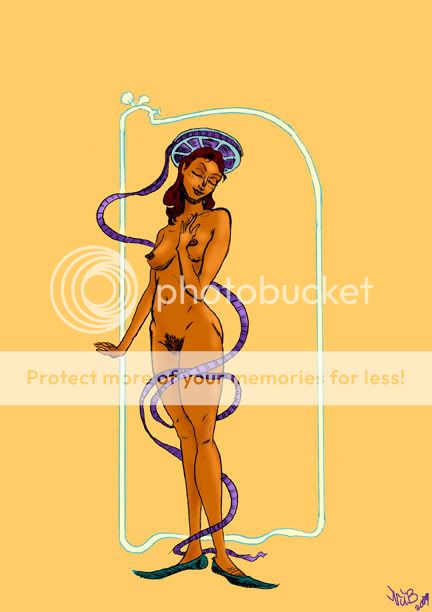
* Dig the fancy new trade dress for Matt Fraction and Salvador Larroca’s very good Invincible Iron Man, designed by Rian Hughes.
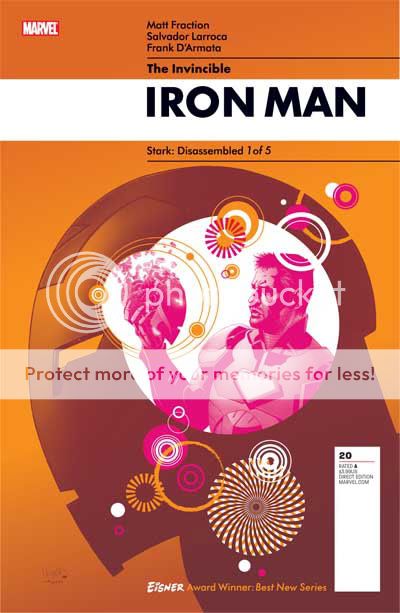
* Lego David Bowie, ladies and gentlemen. Let’s Dance era, by the looks of it.
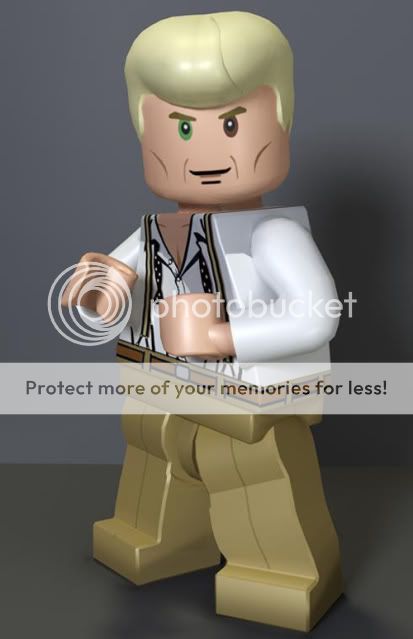
* Looks like I’m gonna get to see Paranormal Activity in the theaters. Still torn about this whole pseudoviral thing, but kudos, it’s gotten the movie some attention, I suppose. The movie’s also playing along with a pretty awesomely diverse array of horror movies at the Film Society of Lincoln Center’s third annual “Scary Movies” festival.
* By all means download Matthew Perpetua’s “Best of Ghostface Killah” mix. There’s just nothing else out there like Tony Starks.
Carnival of souls
October 2, 2009* If you read any SPX report this year, make it Jog’s: Subtitled “Comics and Connecting Fabric”–in that order for a reason–it’s mostly an excuse to review nearly everything he got at the show, including a bunch of Cold Heat comics, Driven by Lemons, Ganges #3, James McShane’s Archaeology, that weird “fuck you Craig Thompson” minicomic, the Buenaventura three-for-all, Jonathan Chandler’s 2BY2, and Marvel Fanfare #40 featuring holy shit David Mazzucchelli:
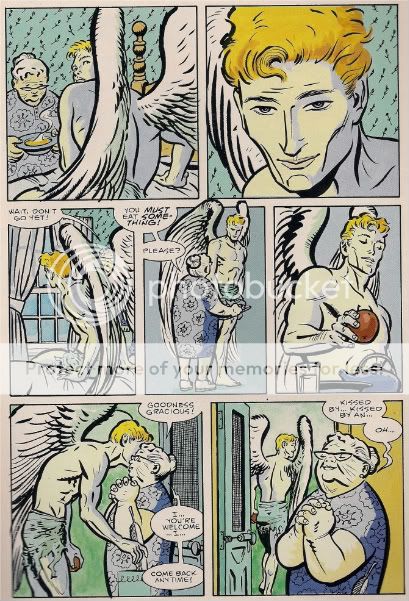
* Frank Santoro’s brief report contains some gems too. For example, this was apparently the first time Frank met John Porcellino, but they’ve been corresponding for sixteen years! Also, there was a couple of the original “Gloriana” Supermonster issue by Kevin Huizenga for sale at the PictureBox table?!?!
* The Are You a Serious Comic Book Reader? crew continues weighing in on SPX: Here’s Sammy’s second post, and here’s site quasi-editor Brandon Soderberg commenting downblog. Both guys (Sammy a bit more stridently) decry what they perceive as an unthinkingly oppositional stance on the part of the independent comics community regarding “mainstream”/Big Two/superhero comics. Which I suppose is true for some people? Maybe? Gary Groth, for example, though I don’t think anything Gary does is reflexive, except maybe arguing with Tom Spurgeon. Indeed, when Sammy slams Jeffrey Brown’s loving Transformers parody Incredible Change Bots as poorly drawn and irony-filled and therefore acceptable to the indie-comics hoi polloi in a way that unnamed sci-fi comics pioneers aren’t, or works in a sarcastic dig about how the only pamphlet-format comics that are cool to this crowd are published by Fantagraphics, I start to detect an oppositional militancy of a different kind. And one that’s largely waging war against an army of strawmen to boot: Judging from the Critics Roundtable, for example, Gary and Rob Clough’s “no superheroes please, we’re critics” stance is a minority position, while the notion that indie people don’t like pamphlets is belied by all the hoopla about the Buenaventura and Ignatz lines, Cold Heat, etc.. I totally agree that the new wave of altgenre comics is thrilling in part for how it doesn’t take a purely oppositional stance, but the extent to which by virtue of their existence they’re taking slaps at Clumsy or Blankets is by far the least interesting thing about them to me.
* I got my Uzi back, you dudes is wack, face it, The Horror Blog is back! And spending the month asking various horror luminaries to list their top ten horror films to boot.
* The astroturfed “word of mouth” release pattern for Paranormal Activity continues, with a bunch of added towns and a contest to add more. Whatever works, man, though particularly after reading Jason Adams’s report on the bungled midnight sneak preview I almost went to, I’m a little sour on the way the studio’s handling this, even though in principle I think any deviation from the standard “how it does on Friday night opening night basically determines its entire future” operating procedure ought to be applauded.
* Ceri B.’s month-long series of short sharp shocks on horror continues with a concise salute to Kyle Reese’s concise explanation of how the terminator works in the first Terminator film. Weirdly, I was just re-reading my T1/T2/T4 review roundelay last night, and it too centered on the effectiveness of that speech.
* Kevin Mutch and Andrei Molotiu debate the readability of abstract comics. Can they work as “stories,” i.e. things you sit down and read by proceeding from beginning through middle to end, or are they best experienced as “ambient comics,” i.e. by flitting in and out and back and forth through them at your leisure, accruing an understanding in dribs and drabs rather than in one discreet read-through? I think I’m on Team Andrei here–I have yet to dive into his Abstract Comics anthology, but in my experience (Hankiewicz, Nilsen, Cotter, Mattotti) abstract comics are not as attention-deficit-disorder-defying as Kevin makes them out to be.
* Part Charlie White, part David La Chappelle, part “when you see it, you’ll shit bricks” internet meme, the horror photography of Joshua Hoffine stages scenes based around various familiar horror tropes, sometimes with a no-beating-around-the-bush tip of the hat to famous works, often with an admirable willingness to go there when it comes to linking horror to fairy tales’ menacing of children. Here are a couple strong images:


* The Love & Rockets Facebook page’s photo gallery is indescribably awesome. It’s the kind of thing where there’s a picture of Jaime and Gilbert Hernandez with Paul Westerberg and it isn’t even close to the coolest photo. Here are a couple of my favorites:
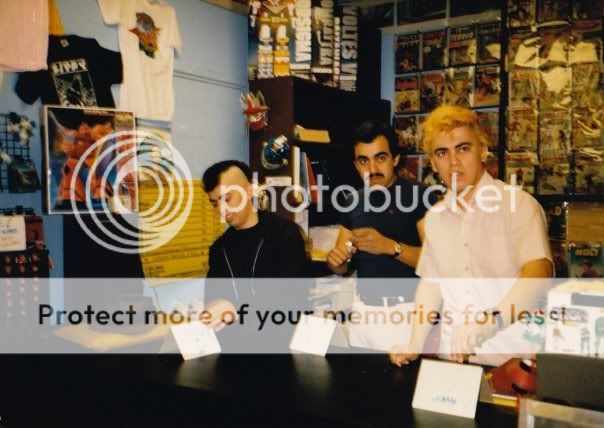
Punk as fuck, circa 1982.
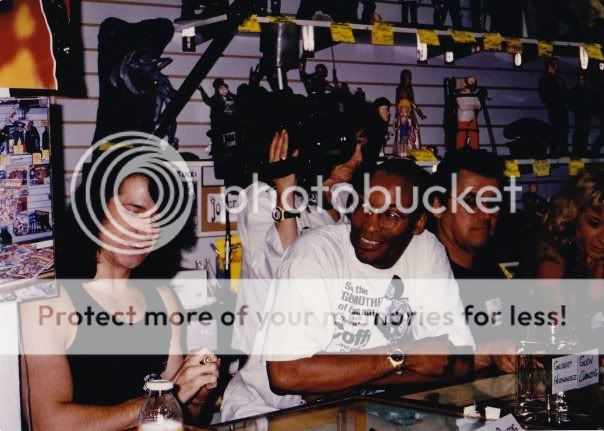
From left to right, that is, I shit you not, Glenn Danzig, John Singleton, Beto Hernandez, and Nina Hartley. Other photos feature Robert Crumb and Aline Kominsky, Russ Meyer, Hank Ketcham, Sergio Aragones, the Flight of the Conchords, Vampira, and Michelle Shocked. Jiminy Christmas, go become a Fan and browse the whole thing. (Via Mike Baehr.)
Comics Time: Cold Heat Special #6
October 2, 2009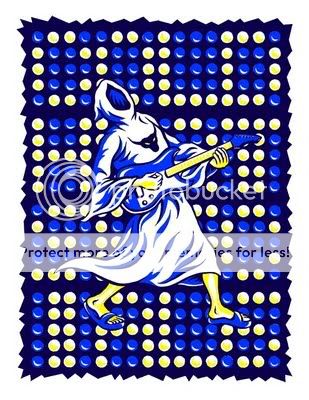
Cold Heat Special #6
Chris Cornwell, writer/artist
PictureBox, September 2009
24 pages
I think it was $10
Chris Cornwell is the joker in the Cold Heat deck. The only Cold Heat Specialist who doesn’t create his installments of the spinoff series in collaboration with Cold Heat-proper cocreator Frank Santoro, he’s also the farthest afield from CH‘s usual tone of wistful, sensual menace and transcendence. His first CHS involved an assassin whose dayjob was rock stardom and the evil Senator Wastmor piloting a giant minotaur robot. Similarly, this issue is summed up by that gorgeous, iconic cover, featuring some kind of robed Satan worshipper rocking out; this leads into an opening sequence in which a band comprised of monsters “rehearses” by destroying their own equipment in a montage that reminds me of Yacht Rock’s take on Van Halen in terms of sheer half-parody/half-salute comedic rockitude.
Indeed the whole comic feels a bit like a montage. There’s that opening Monsters of Rock sequence’ a credits-spread scene of a nude Senator Wastmor getting drunk and drowning in an ocean of his own puke’ a “secret history of Cold Heat” story (really the core segment) about one of Wastmor’s ancestors attempting to sacrifice a beautiful girl to his demonic masters in colonial days before being thwarted by alien protectors; a near-abstract spacetime-rupturing transition sequence linking that centuries-old adventure to the present-day viewing of a Chocolate Gun videocasette by other aliens; and a glimpse of how the aliens’ power affects CG lead singer Joel Cannon juxtaposed with how Cannon’s music effects Cold Heat heroine Castle. Got all that? It can be tough to follow, particularly toward the end of the book, but following it doesn’t appear to me to be the point. It’s more a case of latching on to isolated images and impressions, meaning that Cornwell in his goofy slapstick way is mimicking the more lyrical approach of Santoro and Ben Jones in Cold Heat itself. And he can do it, too–he’s got the visual chops to bounce back and forth between slick cartooniness (the cover, Wastmor’s bender), rough-edged Fort Thunder/Closed Caption Comics-style monstrousness (the band, the aliens), non-narrative visual-driven psychedelia (the transition sequence), and on the last two pages, a glimpse of Cold Heat‘s trademark music-as-emotional-salvation leitmotif. Plus the book is as lovely an object as the CHS series has seen so far, with that killer, please-make-it-a-poster cover and two gorgeous color pin-ups literally pasted to the inside covers. If only every comic-book franchise had this kind of quality control.
Carnival of SPX
October 1, 2009* So! You’ve all read:
– My con report (check out the comment thread for Rob Clough and Xaviar Xerexes’ thoughts, too)
– Johanna Draper Carlson’s Critics Roundtable panel report
– the transcript of the New Action panel
– and listened to the recordings of the New Action and Critics Roundtable panels that I posted
Right? Good, now we’re all caught up.
* Very interesting: Sammy at Are You a Serious Comics Book Reader? appears to be the ideal audience for that New Action panel I did. You could tell this from the books he got at the show–Benjamin Marra’s Night Business is heavily touted–but also from his take on the panel itself:
At a place dominated by sad-ass comics about exes and your parents dying, it’s shocking to see comics creators that want to have fun, hopefully “indie” will start to mean “independent” again and not simply “everything but super heroes”.
But! The closest that panel came to an argument occurred when I asked the panel why they didn’t feel the need to visibly react against the “mainstream,” superhero-dominated action-adventure comic tradition, either in the negative way that the likes of Daniel Clowes and Chris Ware did, or really even in any way at all. While Shawn Cheng argued that the omnipresence of nerd genres in today’s culture obviated the need to comment on them for or against and Ben Marra stated that he loves superhero comics, albeit not contemporary ones, Frank Santoro literally pounded on the table while arguing that we shouldn’t be discussing superhero comics at all–it’s an instant turn-off to the new generation of comics readers, he said. So even if the sort of negativity directed toward superhero-style storytelling by the original altcomix generation is less prevalent than it once was, the newfound openness to superhero-style storytelling Sammy detects isn’t universal–in Frank’s case, at least, it’s more a sense that that genre shouldn’t be the lens through which we view what we’re doing, good, bad, or indifferent. (Via Heidi MacDonald.)
* In terms of con reports, I enjoyed Chris Mautner’s six observations, and Rob Clough’s interesting take on the proceedings, which included musings on the way that webcomics, college comics education programs, and the fall of straightforward indie-genre comics coupled with the rise of the “New Action” variation of same have all gone into shaping the show.
* Heidi MacDonald notes that attendance was up a whopping 19%. I’m glad to see I wasn’t hallucinating!
* In Heidi’s longer report, she (like Rob) summarizes several panels, as well as reflects on how the Team Comix generation of alternative comics creators has largely abandoned the show for New York City book deals and Act-I-Vate strips, leaving it in the hands of a different generation. But I would disagree with how she (and to an extent, Rob) characterizes that transition:
SPX (and MoCCA, but I haven’t been to APE or TCAF so I can’t say what the sitch is there) is now the province of the very young and aspirational, and their work is even more personal. As CCS, SVA, MCAD, SCAD, and other art schools turn out class after class of highly competent and well-informed art students, it’s become a bit more of a pageant, in some ways. Young cartoonists get their Xeric, put out a perfect book, spend a season or two as the deb of the year and then…some will go on, some will just become memories in the shoe box.
On a basic level I don’t get how they can be both more aspirational and more like pageant contestants ending up in the shoebox of history, but that’s not the main thing. It seems silly to say I have a philosophical difference with Heidi over this, but that’s the closest description I can come to regarding the primacy she frequently affords youth and ambition in terms of who and what matters in comics.
Here’s the thing: The core table presences at SPX are still Fantagraphics, Top Shelf, and Drawn & Quarterly, the former two of which were staffed this year by Gary Groth & Kim Thompson and Chris Staros respectively–veterans, to say the least. Meanwhile, PictureBox, Buenaventura, Bodega, Sparkplug, and AdHouse may seem like the new wave, but guys like Dan Nadel, Frank Santoro, Alvin Buenaventura, Randy Chang, Dylan Williams, and Chris Pitzer have all been fighting the good fight in the alt- and artcomix trenches for a long time now. At the Ignatzes, the big award-winner was Jordan Crane, who made his bones when I was picking up cheerleaders and just keeps getting better. Since I started going to SPX again with the move to the new hotel, my big discovery was Geoff Grogan’s Look Out!! Monsters–Geoff’s a lot of things, but he’d be the first to tell you that a young turk isn’t one of them. Frank Santoro and Dustin Harbin are in many ways two emblematic East Coast altcomix figures right now; neither of them is some fly-by-night college boy. And that’s even before we get to the the fact that the guests of honor this year were Gahan Wilson, Carol Lay, and John Porcellino.
Of course the place is stacked to the rafters with kids makin’ comics (many of whom are doing so online in a way that the old folks never dreamed of), and that youthful enthusiasm is part of the lifeblood of comics just like it is in any other art form. But I don’t think it’s necessary or desirable, or even accurate, to make a grand statement about how they’ve inherited the SPX earth, to contextualize things in terms of “Look out, us fogeys, the torch has been passed, the kids are coming up from behind.” Characterizing things that way is bad for fogeys and kids alike. It leads to regrettable phenomena like successful, talented cartoonists spending valuable panel time discussing a freaking Hi & Lois comic. Who cares what the Hi & Lois guy thinks about your awesome, popular comics? Unless you’re setting up a narrative of old guard versus new blood, what difference does it make? Do you, folks! It’s not a contest, it’s not a beat-the-clock situation, and where your work shows up or how old you were when you made it matters much, much, much, much, much less than whether or not it’s good. This should be truer at a small-press expo than anyplace else.
But if you’re talking about SPX primarily in terms of the social scene–who saw and was seen, who made the drive and who didn’t, who has the best hotel-room parties, who went on the karaoke expedition, who closed out the bar, who went to the award show where they gave out beer bottles–then it stand to reason you’re going to focus primarily on the youthful and strong-livered, rather than, oh I don’t know, dudes like me who literally collapsed from exhaustion on his hotel bed at the stroke of midnight-thirty, or all the folks with young kids. But that’s a distortion. Comics is an artform, not a hang.
This may even out some as the days pass, but I’ve read way more about the fact that the karaoke joint was closed than I have about what people thought about the books they got at the show, other than some perfunctory stabs at a “book of the show,” which is as much about Heidi’s “pageantry” concept as it is about art. I wish I saw more posts like Johanna’s panel report, or Chris Mautner or Rickey Purdin’s “here’s what I bought” write-ups–both of which are sort of awe-inspiring in just how much compelling stuff there was to purchase and read at that show–than photo parades of folks holding beers. I think that focus offers a distorted view of what SPX is, what SPX means, and why SPX matters. SPX and altcomix in general may be full of the young, but it’s not a young person’s game.
Carnival of souls
October 1, 2009* My guest in the Strange Tales Spotlight today is Jim Rugg.
* For those of you keeping score at home, I think I’ll be ponying up three more SPX posts: A Carnival of SPX link post (hurry the fuck up Jog, I’m on a deadline here), a “here’s what I got” post (which, honestly, are the most important posts, because they’re about comics!), and probably, because I’m a glutton for punishment, a transcription of the Critics’ Roundtable panel.
* This seems like news a lot of you can use: Sammy Harkham is facilitating the sale of original art from Bart Simpson’s Treehouse of Horror. Make him an offer, Simpnerds!
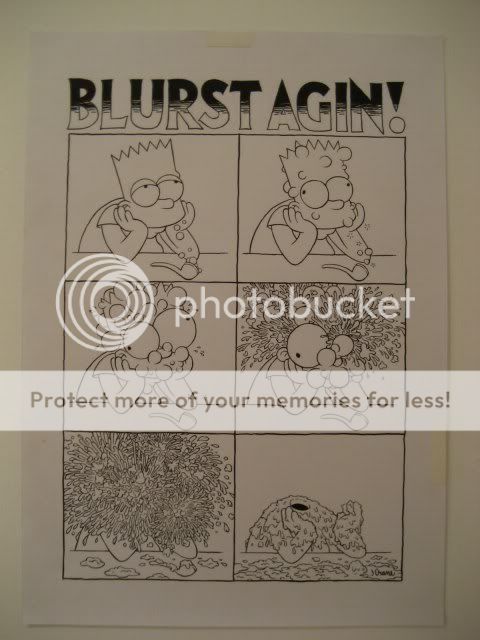
* “Is this a musical table?”: They can nominate him for all the Oscars in the world, but to me, Richard Jenkins will always be Agent Paul Harmon, Bureau of Tobacco, Tobacco, and Tobacco, from David O. Russell’s Flirting with Disaster–one of my all-time favorite comedies, and one of my all-time favorite comedic performances. Lebowski-level shit, dude. Anyway he’s going to be in Cloverfield director Matt Reeves’s egregiously titled remake of Let the Right One In, Let Me In. So I’m interested.
* Yeah, you’re gonna wanna peruse Curt Purcell’s gorgeously sleazy Flickr gallery of vintage paperback covers. Trash! Go pick it up!
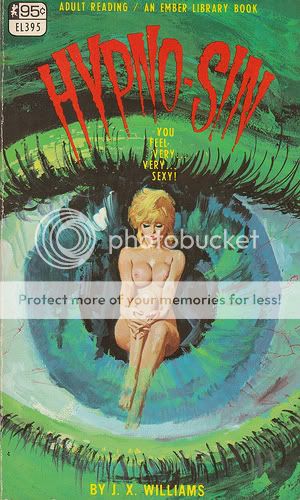
* Holy shit, Nine Inch Nails’ Broken movie is on YouTube? Um, how is that possible? Trent Reznor was torture porning when torture porning wasn’t cool.
* Paul Pope adapts Dune, Wednesday Comics-style. Lovern Kindzierski’s colors kill.

* You should check Renee French’s blog every day, because every day she posts things like this:

* My friends at The Cool Kids Table celebrate their one-year blogiversary once again with a cover gallery of comics they loved over the past 365 days.
* Ceri B. kicks off a month of daily horrorblogging with a post on a killer paragraph from Edgar Allan Poe’s “The Masque of the Red Death.”
* Real-Life Horror: Meet Fouad al-Rabiah, the innocent man we knowingly tortured for the express purpose of extracting false confessions. (Via Andrew Sullivan.)
* Do I ever just stop and say what an amazing, consistent blogger Aeron Alfrey of Monster Brains is? Eye-popping images day after day after day. Today’s gallery is the latest in a series of posts on monstrous video game art. God how I loved Karnov and Rygar! You really, really need to stick Monster Brains in your RSS reader.


SPX 2009: The New Action
October 1, 2009Below is a transcription of the panel I hosted on the new wave of alternative-genre comics, featuring Frank Santoro, Benjamin Marra, Kazimir Strzepek, and Shawn Cheng. You can listen along by downloading an mp3 recording of the panel here.
—–
Sean T. Collins: Well, welcome everybody. Thanks–I appreciate your patience for our late start here. My name is Sean T. Collins. I have a blog called Attentiondeficitly–bleh, even I can’t pronounce it–Attentiondisorderly Too Flat at AllTooFlat.com. I also cover comics for Maxim and I’ve written for The Comics Journal, Wizard, The Comics Reporter, Robot 6, and The Savage Critic. This panel is about “The New Action,” and this is our New Action Pack, as I’ve taken to calling them. [Laughter] Here on my left:Frank Santoro is the–
Frank Santoro: [begins clapping] They’ll never know on the tape. [Laughter]
[audience applause]
Sean: He’s the author of Storeyville, Chimera, and Incanto. In terms of the relevant comic here, he’s the coauthor with Ben Jones of Cold Heat, and the coauthor with a murderer’s row of talented young cartoonists of the Cold Heat Special series.
To his left is Benjamin Marra. [audience applause] Ben is the author of Night Businessand Gangsta Rap Posse, which are all on sale for a whopping $5 total upstairs, so I definitely recommend that when this panel is over, you go to his table and purchase them.
Kaz, I’m not even gonna try with your last name…
Kazimir Strzepek: “Strepek.” The “z” is silent.
Sean: Oh, that’s easy! Oh wow, how about that! Kazimir Strzepek. [audience applause] He is the author of The Mourning Star, two volumes of which are currently available; also, his stories have appeared in various anthologies.
And to his left is Shawn Cheng. [audience applause] Shawn is one of the co-founders of the Partyka group of very talented minicomics creators. Kid Coyote & Whiskey Jack vs. the King of Stink–did I get that title right?
Shawn Cheng: Yes.
Sean: Wow! [It’s actually Kid Coyote & Whiskey Jack Meet the King of Stink–STC]…and The Would-Be Bridegrooms are two of his more action-related comics. He is also one of the artists, along with Zak Smith and Nicholas DiGenova of the webcomicOn the Road of Knives, which you can tell from the title is pretty exciting.
So this panel came together when Bill Kartalopolous saw that I had frequently listed some of the comics done by this group in various posts I’ve done online. It seems to be an informal school of comics that are based on action/adventure/fantasy genre elements but are also defiantly and definitively not a part of the mainstream action-adventure tradition that’s dominated North American comics for decades now. One thing I’m curious about with all the panelists, particularly those of you who might have started out doing comics of a different direction: How did you come to start doing this type of material, versus non-genre fiction or nonfiction or autobio or things like that? The genesis of these particular works or just your interest in it in general…
Frank: Kaz? [Laughs] I know for me, I did a comic called Storeyville in the ’90s. It was an attempt at–I had seen Chris Ware and this was my reaction to Chris Ware. It was really straightforward. I was trying not to do a genre thing. I did a story about a hobo in the Depression. So I was trying to get out of genre and try to do a short story, but the stuff I did for fun looked like Jack Kirby. The stuff that I did for fun, to draw to warm up for my book for drawing every day–my serious comic book, my serious novel short-story wannabe–I remember Chris having a big impact on me, but for fun I drew Kirby robots. They were just these Kirby characters, and they just fought each other in a Danger Room kind of setting. I never published them; they were just fun for me. The current project I’m working on now was the idea of my co-creator, my co-conspirator Ben Jones. We said “let’s collaborate,” and he said “I wanna do a story about a girl ninja.” This was after the movie Kill Bill. It was a curveball to me, and I wasn’t doing work like that, and for me it felt like a challenge: “Can I make a comic in this tradition? How would I do it? And it was promptly rejected by the biggest distributor who distributes comics. [laughter] I obviously didn’t hit the mark according to what the mainstream desire for that kind of work is. But then it’s been really fun for me. A project that was supposed to be a year long turned into four years, and now I’m still having fun working on this material because there’s a lot of room to play with conventions in this material.
Benjamin Marra: I was living in Philly for four years, and I lived in a really terrible apartment for a long time. I’d come home from work–I was working at a newspaper–and I Netflixed like nobody’s business. And I also had this really great–
Frank: What’s Nobody’s Business?
Ben: Netflix.
Frank: What IS Nobody’s Business?
Ben: I don’t–
Frank: Oh, you mean–I thought it was a movie! “I Netflixed Nobody’s Business.” I’ve never heard of that movie!
[Laughter]
Ben: No, I’m using Netflix as a verb. [Laughter] So I did a ton of Netflix, and I had this great video place in Philly that had this insane wall of Eurotrash. I rented a ton of Italian ’70s thrillers called giallo. I rented so many of those things and watched them all. I was like, “I wanna make a comic that’s like these movies.” They’re all sort of similar: It’s always these hot chicks getting killed by some mysterious slasher. They’re really sexy and they really have no story whatsoever. [Laughter] There’s really gratuitous violence. I was like “Man, this is awesome.”
But the other thing was it was also a reaction, I felt, to a lot of what was on my radar for indie comics–a lot of, like you mentioned, autobiographical stuff. I was like, “I don’t really care.” A lot of that stuff, formally, is really excellently crafted, but the subject matter–I just didn’t care about some wimpster’s life and how he couldn’t get chicks. I just couldn’t stand that. I wanted to make some action comics that were a little bit more, I don’t know, visceral, and a little bit more base in what their ambitions were, which was just sex and violence and revenge and killing and stuff. [Laughter] And nudity. [Laughter]
Kaz: I started just drawing comics with some friends in my area. We did a comic calledPM for “Project Masturbation.” It was pretty much just us–kind of like an Eightballanthology for our local town. Just little weird things happening, little short stories, but no reoccurring characters or anything like that. I always felt like I was going to try to exercise and try different ways of expanding drawing comics for myself. After that I did a comic called Spaz, which was more Johnny Ryan influenced. It’s mostly potty-humor one-gag strips, some recurring characters, kind of situational, based off of two neighbors and their cat. It’s really embarrassing stuff. When people bring it up to me now, I don’t like to look at it. But I thought, “Okay, I have these reoccurring characters and they’re kind of generic and flat, but I want to exercise and expand some more.” So I wanted to make a story that was a lengthy thing. I didn’t really, back then, realize what I was getting into with The Mourning Star, which is kind of an epic. [Laughs] It’s a really long comic, and I don’t know if I’ve bitten off more than I can chew. It’s kind of swordfighting creatures in this post-apocalyptic world. I really wanted to exercise and try more with character development and action and fun, and really incorporate the joy that I get from drawing. I really love drawing things exploding and people getting in fights and different dynamics. The attraction to comics, for me, is being able to render these different series of actions and movement. That’s what really attracted me to doing The Mourning Star. So yeah, I’ve been drawing all the time. [Laughs] Or trying to. And drinking. [Laughter]
Shawn: For me, I kind of, like the rest of these guys, stumbled onto this genre, I guess. It wasn’t really a conscious choice. I had been drawing a bunch of weird monster creatures and posting it on our website. One day, my friend Zak called me and said, “I notice you’ve been drawing a bunch of weird monster creatures. What’s your plan with them? What are you gonna do with these guys?” “I don’t know. I don’t have a plan. I’m just drawing these guys for fun.” He suggested, “Well how ’bout you draw a monster and then post it on some website, and then I’ll draw another monster, and then you can draw the two monsters fighting each other. We can go from there.” I said “Sure, why not?” Now we’ve been doing that for about two years. We have a bunch of stuff going on. There’s some narrative in there, though you have to look at it pretty carefully sometimes to suss it out since it’s more a narrative corpse-like exchange kind of thing. It’s not a traditional action comic where there are choreographed scenes, because I don’t know what’s gonna happen next.
Frank: That’s interesting.
Shawn: I can just do a set-up and see what happens when Zak gets the drawing. The best sequences so far are when we do rapid-fire exchanges. I’ll do one and he’ll do something almost right away. But a lot of the time, it’s more results like I’ll show two monsters jumping at each other, and then in the next panel one has already decapitated the other. [Laughter] And you have to fill in the blank. I don’t think we’re consciously defiant of any standard out there. It’s just we’re doing things that we like and that come naturally. It’s a little bit adolescent, I guess.
Sean: Well, On the Road of Knives is literally a game in one way, and I’ve heard from all of you that it’s about doing what’s fun. Is it recapturing an element of the childhood joy you got from drawing, at all? That’s something I’ve thought about recently, having read Brian Chippendale’s Ninja, which I would say is a New Action comic if ever there was one–it literally takes the comics he did when he was 12 and builds, in the present, a narrative off of them. Is that something, in terms of bringing in video game influences or comic influences or movie influences that you liked when you were a kid, or just the act of drawing?
Kaz: Definitely, for me. I was really into Legos as a kid, and I used to build little mountainscapes and have my warriors get ambushed. There’s kind of playing God, playing, making things happen, your own adventures in your mind–I stole that. That’s how drawing comics is for me: I’m able to create these stories and meld different events to happen. It’s a fun play for myself, and then I let people read it and hope people like it.
Ben: For me, I feel like the two comics I make are definitely speaking from a 13-year-old voice that is still inside me. Tone is a really important element in what I’m making, so I definitely wanna hit this chord where it’s this idea of adulthood or idea of the city or urban landscape where it’s from a kid’s or an adolescent’s understanding of that world that they don’t really have a whole lot of contact with or understanding of outside the media they’re bombarded with.
Frank: I just wanna talk about–I’m really resisting trying to talk about Hitchcock movies or Fritz Lang or genre movies or Westerns, stuff like this, but I want to speak to the conventions that are there within something like a romance comic or a Western or a sci-fi comic. There are these very specific, traditional structures that exist for comics. Somebody like Kirby, who invented the romance comic, more or less invented the superhero comic, had a big hand in the sci-fi comic, the Westerns, and everything–by the ’70s, he was combining all this stuff. He’s just telling “Boy meets girl, boy loses girl, boy gets girl”–it’s just like any traditional movie structure like that, like Hitchcock or Fritz Lang or something–but for me as a maker, there’s a plug-in structure that I directly connect into. So I’m attempting to break down the way they’re structured. Most comics are 24 pages, that was the way they were always made back then–not back then, but still to this day for the most part–so I try to have arcs that go up and down these 24 pages. But now people make 700-page graphic novels, and it’s a very different way of presenting your work, it’s a very different way of executing your work. So for me, I used to make, and still make, kind of Fellini-esque art-comic riffs, where I go on and on and on and on. I like to be indulgent in my drawing. But in 24 pages, to tell the story that I wanna tell, I can’t be indulgent. I have to open the throttle. So I’m trying to plug into very specific narrative structures.
Ben: Just to add on to that–even a lot of mainstream comics, this whole decompression way of writing comics these days–I found that really really frustrating. I remember reading this issue of New Avengers by Bendis, and it was just a long monologue by Spider-Woman. I was like, “Twenty-four pages, I’m reading this one character, and hardly anything fucking happens? Man, this sucks! I can’t get into any sort of story here.” I don’t know what they’re writing for, but they’re making these really long, epic, blown-out superhero stories, and it’s really gotten away from those 24–
Frank: Yeah. It used to be you’d get a comic and it’d be contained. Even if it was aFantastic Four comic, it was contained within that. Romance comics, Western comics, everything–whether it was four stories in 24 pages or one 24-page story, it’s a different way of being in the narrative structure.
Sean: Does the fact that you are doing action enable you to do something visually that you wouldn’t be able to get at without that sort of activity going on, in terms of character design or layout or just how you’re conveying what’s happening on the page?
Kaz: I would like to do a romance comic with my characters. That’d be kind of interesting, I think. They’re warriors, but they’re like “We fight, but we love, too!”
Frank: If anybody here hasn’t read Jack Kirby’s New Gods, that’s what that is. It’s a romance story in the guise of a really weird sci-fi epic. He invented romance comics, so thirty years later, instead of doing romance comics, he’s doing this bizzarro science fiction story and it’s just about the pathos of these characters. It’s a remarkable achievement, but people just see it as, “I don’t wanna read that–that’s a superhero comic” or “I don’t wanna read that–that’s a sci-fi comic.” He’s playing with conventions, he’s tricking you. It’s just a boy meets girl story, and that’s what interests me. But in terms of character design, I just want to…Everyone’s familiar with David Mazzucchelli, right? David Mazzucchelli said he was going to school for traditional figure painting and drawing and he got a job at Marvel Comics because he was really good at drawing figures in space. He wanted to draw dynamic action, figures in space, so he draws Daredevil. But look at the evolution: He’s now doing a completely different style of cartooning. He’s gone the other way, whereas the alternative guys now want to go toward what David did. They wanna be this mainstream guy. I find that really interesting.
Sean: That’s another thing I was gonna bring up: I think Jaime Hernandez was probably the last big alternative cartoonist who got away with unabashed enjoyment of genre comics. After that, you had story elements like the guy dressing up like Superman and killing himself in Acme Novelty Library, or Eightball #23–
Frank: You mean like an irony?
Sean: Sort of a critique of superheroes, mainly, but that kind of storytelling in particular. I don’t really see that in any of you guys’ work. Shawn, I barely see a reaction to that material of any kind at all in yours. Why do you think you guys don’t feel that need to comment in a negative way like a Clowes or a Ware has done?
Shawn: For me, I don’t feel that there’s that tension between indie and mainstream comics, or that the superhero and action genre is a fringe thing. You have primetime TV shows about vampires and superheroes now. It’s expanded to a certain degree so that you can be doing this kind of work without it automaticall being a critique.
Frank: Yeah. May I interject–I think that this generation, the younger generation, doesn’t have the same sense of self-loathing that the Clowes generation had. My comic Cold Heat is a complete, sincere statement. There is no irony whatsoever in it. It’s total fun. It’s not an ironic take on these characters.
Ben: It’s like a celebration of those points.
Kaz: And being able to do it on their own.
Frank: Yeah, but having fun with it. They, that whole generation, was trying to get away from that. I think at least my peer group, and younger, doesn’t have the same kind of issues with that.
Ben: I think Chris Ware probably really loves superheroes in a lot of ways, that genre.
Frank: No. [Laughter]
Ben: I love superheroes, but–
Frank: But it alienates people! The more we talk about it. Like, the last panel [the Critics Roundtable]–I don’t wanna hear critics like, “But then superhero comics! But thenAcme!” It just alienates people. The new readership for comics don’t wanna talk about superheroes! Especially girls. They don’t wanna hear it! So the more we’re like “But we love superhero comics”–the problem with that is that it just becomes this mantra, and the work suffers for it. I don’t have a problem for it, you don’t have a problem with it, but for the most part, there’s still this desire to be engaged in the mainstream–
Ben: Well, I do have a problem with it, because I hate the way superhero comcis are written. The stories are all just this property management system.
Frank: It’s the corporate work system.
Ben: They’re not actually making any interesting stories at all that are engaging or compelling, they’re just trying to manage this whole spectrum of intellectual properties in a certain way that they can. So when you read some of these superhero comics today, they’re not the same as they once were. I mean, if I’m gonna read a superhero comic, I’m gonna go read a Curt Swan Superman—
Frank: Right right right, I know, but it’s tough because the new readership doesn’t get that. They go into Barnes & Noble and they see what there is and there’s so much of this and so little of that. I mean, that’s a whole different discussion, but I think that what we’re trying to do–and I’m not trying to speak for everybody–this is just a new branch in this tree. This is what we’re all trying to figure out. We’re trying to go out on new ground, you know?
Sean: One thing I see that I think is going on in several different ways–perhaps in the publication of the Fletcher Hanks collections and even Supermen!, the old-school Golden Age superhero collection that Fantagraphics put out–some of what you guys are doing, and correct me if I’m wrong or if I’m overstating the case, is reclaiming action-adventure tropes away from that sort of [traditional] material and exploring other venues in which it’s done, whether it’s manga, action movies, video games in particular… I’m curious as to whether these are things you guys are thinking about when you’re making your comics. Bringing in other ways of showing action.
Frank: I just wanna say I think that’s a great point, because those two books are a big deal for the general public’s understanding that there were weird comics, weird quote-unquote “outsider” comics, before the Silver Age Marvel stuff. You know what I’m saying?
Ben: Totally.
Frank: There’s a reclamation of this older pulpy weirdness in comics that could be monster, could be sci-fi, could be Western, whatever, and weren’t just costumed heroes.
Ben: Yeah. Those two books, the Fletcher Hanks books, were really influential on me as far as coming at comics from a naive way of working, a fundamental way of working. But to talk about action and other things I’m thinking about–I love a lot of action movies that were created in the ’70s and ’80s. Those are things I think about constantly. Especially Rambo: First Blood Part II. [Laughter] I love that.
Sean: I know what you mean! [Laughs]
Ben: You know what I mean? When the music starts and he shoots that guy on the waterfall with the bow and arrow and the guy explodes? [Laughter] It doesn’t get any better, for me. That type of action? At the time, I think they were just like, “This is not ridiculous at all.” But now, looking at it from the prism of time, it looks totally humorous. I like that. That’s the type of action I’m–
Frank: But he’s talking about video games like–
Ben: Grand Theft Auto?
Frank: Yeah.
Sean: Well, not even Grand Theft Auto. I was thinking…I remember when I first readTeratoid Heights by Mat Brinkman–just the way that the characters explore space, the sense that you’re moving on to different levels. I think that Brian Ralph, who was supposed to be here but could not be here as I’m sure people have noticed, did a similar thing with Cave-In.
Frank: Oh, totally.
Sean: To the point nowadays where you have guys like Bryan Lee O’Malley who’s doing an action-romance comic in Scott Pilgrim that’s almost like video-game realism. In the middle of this twentysomething drama, a guy will fight a ninja and get a 1-Up and then move on and go to a bar someplace or play a show.
Frank: I agree with that, yeah, totally.
Sean: I see elements of that with some of your character designs, but also Kaz’s characters moving around and exploring environments, and Shawn’s comics which are, in a certain way, a game to play. Is that something you guys are conscious of, just as a part of your vocabulary?
Shawn: Yeah, definitely. My friends and I have just recently started playing Dungeons & Dragons, the old ’70s version that’s really complicated. We spend a lot of time doing math and looking things up.
Ben: You’re talking about Advanced Dungeons & Dragons. [Laughter]
Shawn: That’s right, AD&D. [Laughter] I think it’s definitely related to what you were talking about with video games. People are playing World of Warcraft and it’s the same kind of thing, but it’s become more formulaic, and what you’re doing is pressing the attack button and walking around. Whereas I think there’s a bit of a reclamation project in being able to say, “Well, instead of just charging at this monster and hitting the button, I’m gonna do something different, I’m gonna walk behind him and do this other thing too.” It’s taking that structure and that world and doing something that you would like to do with it, instead of what we’re seeing on TV or on the movie screen, which always leaves me feeling like, “Wait, they took Transformers and that’s what they did with it?” [Laughter]
Ben: Wait–I love Transformers 2!
Frank: But what about Kevin Huizenga’s Fight or Run?
Kaz: Ah, I love that comic!
Frank: But it’s like abstract shapes. You know that comic? It’s one of Kevin Huizenga’s more recent comics, and it’s sort of a video game, but he breaks it down into almost modern-art shapes of things in space. It’s interesting because he’s breaking the actual cartooning language down and then he’s using, again, a narrative structure of video games and plugging into that. But I wanted to talk about, or get you to talk about, Brian Chippendale and Brian Ralph again, because they come out of a similar school. If you guys are familiar with these comics, Ninja and Cave-In and Fireball and everything? With those guys, their drawings are just so pretty, but they just plug it into a really simple “follow the main character around this adventure land,” and by doing that, they get to do a lot of interesting things formally.
Sean: Yeah. I remember the first time I saw The Lord of the Rings: The Fellowship of the Ring, I saw some 20-minute preview that the movie studio was doing for press. There was this shot when they’re running down the big bridge underground: Legolas shoots an arrow, and the camera follows the arrow until it hits the orc, who then dies. When that happens, the angle switches, and you see that just by following the arrow, you’ve visually described this whole space and opened this whole vista up. I think that’s one of the things that action can do really well, and is perhaps underappreciated when people focus on the genre aspect or the narrative aspect. It’s a way to get you around the page that’s different than more straightforward comics.
Frank: That’s a great point.
Shawn: Yeah. I think there’s definitely an aspect of world-building. Instead of just describing very procedurally, “This happens and then this happens, and as a result this is possible,” I think what Zak and I have realized in doing our project is that it’s actually much more interesting to describe the context that these characters are in, the grimy setting that they’re walking around in. Where this monster’s coming out of, or how he’s revealed, is more interesting than the fracas that ensues a lot of the time.
Sean: Kaz, world-building strikes me as something that’s probably hugely important to you.
Kaz: Yeah. I was hoping with the first Mourning Star…People say “Who’s the main character? Who are we following? Who stands out?” I wanted the whole environment to be a character. You’re learning about their world through them, and they’re kind of like the body parts of this dimension or this place. You learn by reading the comic about the whole world. But they’re not really that special, and I’m trying to express, in a way, that anybody can die. It’s a ruthless survival world, and even if the guy’s a main character, they can be entirely maimed. Just because they’re somebody that’s important in the story at that point–anybody can die for any kind of reason. I’m not trying to be a standard kind of story.
Sean: That’s the perfect transition to what was going to be my last question before I can start opening it up to the audience, if you guys are up for that. I wanted to talk to you about violence. Violence is obviously a core component of an action comic. I’m curious as to whether you think violence–having characters fight, having characters hurt each other and kill each other–does that enable you to say something, and you can interpret that however you want, that you can’t say with comics that don’t have fighting and killing?
Frank [presses a button on his Mr. T talking keychain]: “Don’t gimme no backtalk, sucka!”
[Laughter]
Frank: I don’t know. That’s weird. That’s an interesting question. I know that in autobiographical comics, for example, whether it’s romance or just life or whatever it is, it’s just two people in a room talking. Dave Sim said, “How many car chases have you ever seen in your life? How many fistfights have you ever gotten into? So how do you tell that story from a personal perspective?” So more to your question, does violence…what do I think…My comic is a big Maguffin, though. It’s a big joke. There’s really no fighting in my comic, so much. It’s all this eerie set-up and I’m trying to trick you that there’s going to be some big lightsaber fight at some point, but there really never is.
Kaz: You’re spoiling it, man! [Laughter]
Frank: Exactly! It happens, but I’m trying to trick you, that’s what I’m saying. I’m using those genre conventions, and I’m saying the violence I’m going to depict is more almost psychological.
Kaz: That guy’s guts came out, though.
Frank: Yeah, that’s right. His head exploded. [Laughter]
Ben: For me, I think the reading experience I’m trying to get across is dependent a lot on the violence that occurs in the story. But I think the violence wouldn’t carry the same weight if I didn’t, like with Frank, if I didn’t set it up in a certain way. I have to create a context for the violence to occur, so the soap opera that’s happening–
Frank: Is way more fun.
Ben: Yeah, is actually a lot more fun to develop–the characters’ interactions and their relationships and then the reason why the violence would occur.
Frank: We’ve gotta tell you guys, Ben has tearjerker operating-room scenes where people are dying…
Ben: Right, yeah, it’s super over-dramatic, melodramatic. I don’t know if it necessarily is, like, for other comics that don’t have violence in them…I think the experience we’re trying to create is different. I think we’re probably commenting more on genre itself and less on real-life interpersonal experiences.
Shawn: For me, the violence is more of a stylized–they’re more like tropes. It’s not really–like, the way that Tarantino treated violence in Kill Bill. It’s almost camp. I’m not reveling in the blood. That makes it more, what is it, horror, like Saw VI or whatever? For me, the violence is just a way to release the energy that I’ve hopefully been able to set up in the scene. It allows more for formal play, I guess. I think about it as choreographing the characters.
Sean: Right, it’s more spectacle than some sort of commentary.
Shawn: Yeah.
Kaz: Yeah. For me, actually, I don’t like too much violence–even though my comic has lots of decapitations. [Laughter]
Sean: It does have a lot of decapitations!
Kaz: I just think of different ways of people…when you’re fighting, what if something hits your sword and your sword hits yourself in the head? I think it’d be kind of funny to draw, and so… [Laughter] But stuff like Saw or the Hostel movies that are out–I can’t really watch those. I get really squeamish when somebody’s guts are being poured out and they’re like laughing in their face, like “I’ve got your innards!” “Noooooo!” [Laughter] It’s like, “Oh my God, I can’t! This is too…shock.” I’m afraid, also, as a creator drawing comics, that people think I’m trying to be like “Ah, I’m gonna do a decapitation–it’s in your face!”
Shawn: Body count.
Kaz: It’s not really that. Personally, for me, my story is in a world where I’m just trying to depict survival and the fear of people in this world. Violence is happening, you have to survive, there’s awful people. And also I get mad at work sometimes. I’m sitting in the office all day, and I just wanna draw somebody with a giant sword. I don’t have a sword at home, so I can’t just fling it at people and stuff. [Laughter]
Sean: Well, I’d be happy to take any questions from the audience if anybody has anything they’d like to ask. Yes sir?
Audience Member #1: I’ve got a question going back to what you were saying about video games and multiple levels and all that kind of stuff. Something I’ve been thinking about lately is open-endedness in comics, as opposed to what we’ve seen in quote-unquote graphic novels over the last 10 or 15 years, where you know you’re getting into something that’s like a movie or a novel with a beginning, middle, and end. That’s not the same as what you’re getting in, like, Chris Claremont/John Byrne X-Men where there’s this whole universe to explore, and as a kid, the joy of it is being in there and knowing that anything can happen. There’s a special magic about comics being one panel to the next; to me the best comics are ones where whatever happens in the next panel, you didn’t expect it, and anything can happen. I’m wondering if that open-endedness is something you guys are trying to get back to–get back to that joy of comics you felt when you were a kid.
Frank: Just really quickly, I know that for me that’s hard with Cold Heat, because there’s such a desire to…Everyone’s asking for the collection, but they don’t buy the issues, and they didn’t. I mean, whatever, I don’t expect everybody to buy these issues, but I don’t want it to end. I like putting a comic out twice a year. Forty-eight pages twice a year is pretty great. I want that to keep going, but everyone’s just waiting for it to be collected. I could collect a story arc and put that out, but I want it to be a self-contained thing because that’s what the culture is right now. I need it to be, maybe even financially. It’s a really strange conundrum. [Laughter]
Ben: When you mentioned video games in your question, it made me think of Final Fantasy VII and the way it relates to comics. You’re creating this world, like you’re saying, and there’s this sense of discovery you can have with this episodic story that occurs in this self-contained imaginary world. My friends and I used to sit around in college and watch my friend play Final Fantasy. [murmurs of assent] It would be super-entertaining because there’d be something around the next corner that was revelatory and great. That’s one of the things about having a comic that’s a periodical that’s great–you know you can look forward to that next issue where you’re gonna learn something new. You know it’s not necessarily going to have an endpoint in sight. From a creative standpoint, it’s really a lot of fun to not know. I know where certain things are gonna happen in my story, but I don’t necessarily know how I’m gonna get there, so it’s really fun to try and figure out how those pieces are gonna fall into place within those 24 pages of these serialized issues.
Sean: I just want to interject that in terms of comics that are spiritually akin to the ones we’re discussing, Johnny Ryan’s Prison Pit and C.F.’s Powr Mastrs–those are two books where I literally had no clue what the fuck was going to happen on the next page! [Laughter] And that’s really exciting. Even though Powr Mastrs is serialized and eventually it will be collected, and I guess there’ll be another episode–or volume–episode!–of Prison Pit eventually, that’s the sense that I got. I have no idea where this is going, and that’s exciting to me. Shawn, even you don’t have any idea where On the Road of Knives is going most of the time.
Shawn: No. I thought it was just a year-long thing at first. So when the time came, I talked to Zak and said, “So, how should we start to think about wrapping this up? When does this end?” And his response was, “Well, when one of us dies!” [Laughter] Maybe then we’ll just find someone else, but it’ll just keep going. I think that is really liberating in a way. You don’t have to hesitate to introduce random stuff.
Sean: Do you think–and I hate to monopolize again–but it seems to me that the economic and logistical pressures on you, since you and Zak and Nicholas do this on the web, are much much different than what Frank is dealing with publishing a pamphlet-format comic and trying to get it out there to an audience in this day and age, with Diamond–
Frank: [in a booming voice] It’s over! Just forget it! If there’s somebody out there who wants to do comics, just start doing your iPhone application! [Laughter] Just forget it, you know? I’m telling you, it’s over! Take it from me, I’ve been doing it for 20 years: Just forget about it! [Laughter]
Ben: You might not be able to make a living doing it, but you can still do it.
Frank: Yeah, and you’ll just wanna kill yourself. I like doing my blog because I can upload the drawing right after I do it, like, “Woo! Done! Okay!” Like, scan, done, everyone gets on the RSS feed: “Hey, I love that comic you put on your blog last night!” “Thanks!” “When’s your Cold Heat coming out?” “Uhhh, I dunnoooo….” [Laughter] I’m just telling you–forget it.
Sean: Kaz–again, I’m sorry–but your format is different. It’s not a pamphlet like Ben and Frank’s, it’s not on the web, it’s perfect-bound. The dimensions are different from what you might expect from, like, a manga thing, but it’s basically that size and that amount of content. Do you feel a different set of expectations than these guys do?
Kaz: It’s really stressful, yeah, because I’ll be contained in my room drawing for almost two years, and then it’s sent, mailed out, and it’s published, and I’m like, “Alright, you guys–is it cool? Is it alright?” [Laughter] “I spent two years on this!” Especially with an epic comic. I like these characters, I like the series and working on it, and there’s this constant–I gotta send it out. I have friends who I bounce off ideas and show things to, but people will just move on if I fuck up, and then it’s gonna be…who knows? [Laughter]
Sean: Anybody else?
Audience Member #2: You were kind of getting at this. I don’t see you having as much of a problem with the web, but Frank, when you’re dealing with pamphlets, you’re going for an ideal market that’s kind of–
Ben: Gone.
AM #2: Well, if it’s not gone, part of this is that you guys are floating in between. It’s why when you get a Cold Heat you know what it is and you buy it and you love it. IT’s the action, it’s fucking movement there, which has been gone from superhero comics forever, but at the same time you’re floating somewhere between the indies, and the indies, there is still, as much as people will say they’re tracking down Kirby or Steranko–
Frank: You’re in between these two worlds, totally.
AM #2: Exactly. Do you find that you’re losing your audience?
Frank: I’m trying to gain an audience! Honestly, as an “art-comic guy,” quote-unquote, this was a conceit to all my friends who didn’t like my bullshit arty comics. [Laughter] “Okay, watch this! I’ll make a fun thing for you! Watch this!” It was kind of like a joke at first, and then it becomes real. But I think I have more of an audience now. Even though the alternative comics and SPX–that’s a whole ‘nother discussion, but we’re not living off of this body of comics anymore. They’ve moved on and gone corporate and this is what’s left of fandom. Really, this is fandom. Comics has split, so now we really are in a no man’s land. So it’s an interesting time, though. It’s fun to chart out this territory without–like, the book publishers want 700-page graphic novels. That’s the thing Kaz was speaking to: If you mess that up, and that one page, for whatever reason…The benefit of the pamphlets is you can put out 24 pages at a time, 48 pages at a time, and then collect it, edit in the meantime, see people’s reaction, stuff like that. But when you put it out in one go, it totally changes the expectations of it and the way it works.
Kaz: That’s why you should do minicomics. The first Mourning Star, I did self-publish the first two and sold them. I was able to actually edit it before it was published into a binding.
Sean: That’s an aspect I’ve barely talked about with you, Shawn, but minicomics are obviously as important to you as the web stuff, it seems.
Shawn: Oh yeah. I think the web is a way for me to organize my thoughts before I put it into print form. We’ve discussed how to get Road of Knives into a print format. I think it probably requires some going back and doing some in-betweens, because right now we have, like, key frames of this large storyboard. But publishing on the web is a way for me to feel like I’m getting somewhere, like people are still seeing this and I’m not just off on my own with no feedback.
Audience Member #3: This is for Frank. Have you ever thought about trying to contact more mainstream talent to work with on a Cold Heat Special?
Frank: Oh yeah! I’m working with Jim Rugg. Anybody familiar with Jim Rugg’s work? Jim Rugg’s great. He lives in the same town that I live in. I literally approached Jim: “I’llpay you to draw Cold Heat.” [Laughter] “I’ll rewrite it for you and we’ll pitch it to Image.” And he’s just like, “Okay, I will, but I’m really busy right now!” So I have, but that’s a whole ‘nother ball of wax. I’m working with Jon Vermilyea, I’m working with people that have a broader appeal, and then [readers] sort of come back to the original series. I want Cold Heat to be like Batman, you know? I want Cold Heat: Black and White! [Laughter] I want all these different people to do their takes. So absolutely.
AM #3: Have you thought about more, maybe, classic mainstream artists? I know you’re a big fan of Trevor Von Eeden…
Frank: Yeah, yeah, and Mike Kaluta, all those people. I would love to. That’s the cool thing about comics, too–those people are around. It’s just that I can’t pay Mike Kaluta’s page rate, and my publisher can’t really either, or doesn’t want to. That’s another discussion, but yeah, sure. That used to be way more popular back in the day– someone would do a Madman pin-up or something. That’s possible. Absolutely.
Audience Member #4: How much do you feel confined by your format? Whether it’s the big sprawling manga or the 24-page pamphlet or the webcomic, does that really change the kind of story you’re trying to tell?
Frank: I think so, absolutely. I make everything I make specifically for the format. I’m doing an iPhone comic right now, and I’ve broken down all the dynamics of what that form is. I teach classes on this, Ben took one of my classes–everything is for the format. There’s certain limitations per format but there’s such a broad choice in comics that I don’t feel limited by it.
Ben: For me…Frank is really into process and the way that all relates to the story. For me it’s a lot less of a concern. But I do try and always end on a cliffhanger, so setting that up, I need to measure out how many pages I’m going to do. The way I work is I actually open up an email to myself and make numbers down the left side, 1-22, and then I write in less than two sentences what happens on each page. Then I just sort of formulate…well, I’ll have to measure out, like, “Okay, I need three pages to get to this point, and I’ve got three pages that I need to fill here, so I’ll extend this scene, and I’ll back this scene up.” That’s the only constraint that I feel. As far as the overarching narrative that the story is taking, no, I don’t feel confined. In fact, I really like having just 22 pages to operate within. I’m a really big fan of HBO TV shows, like The Wire and True Blood, and the way that those operate within a 40 minute, 42 minute time frame.
Frank: Ooh, and now the thing with iPhones: They’re not talking about how many pages, they’re saying, “It should be a five-minute to ten-minute reading experience.” [Laughter]
Ben: Really? Wow.
Frank: No joke. That’s what editors are coming back with. I was like, “Well, how many pages do you want it to be?” “Well, you wanna think about it in terms of you’d be sitting in a doctor’s office and you would download an episode of your comic.” [pause] “Okay–got it.” [Laughter] That’s the constraint, you know? Some people are gonna go through that like “click-click-click-click.” Anybody looked at Bone on the iPhone? It actually looks pretty cool. I’m the biggest print guy in the world, but I’m just saying there’s so many possibilities that I don’t feel at all constrained by formats. It’s fun to play with formats.
Kaz: Do these iPhone comics–do they pan and stuff?
Frank: There’s all kinds of different things. You can–that’s a whole ‘nother discussion. [Laughter] It’s actually pretty cool.
Ben: There’s cool stuff happening with that.
Audience Member #5: You guys have been talking about superhero comics now and why you’re doing what you’re doing. I was wondering what you all thought about manga as a whole. In manga, there’s romance, there’s Western manga, there’s cooking manga now–
Frank: Golfing.
AM #5: Yeah, there’s golfing, baseball, everything. Where do you guys see that, especially the super-violent stuff, the Narutos, and the general manga scene?
Frank: Kaz? [Laughter]
Kaz: Uh, I don’t know. I’m, just…I’m not really rich, and so I don’t… [Laughter] I’m sorry, I’m not rich at all! But I can’t afford, like, when I see a wall of manga, I’m just like, I don’t know…
Frank: Okay, but what do you think about all the genres. The stuff you’ve read, what did you think?
Kaz: Oh yeah! It’s exciting. It’s really interesting that they can find stories to tell in different environments. Golf!
AM #5: But in terms of action comics, does that change the way you guys write action comics? Because that’s “The New Action.”
Frank: Oh, totally. There’s a lot of stuff that’s been available recently that was never available. You’d see it in bits and pieces, but…For me that’s been kind of overwhelming at times, because I know this sounds really weird, but I liked absorbing Tezuka through something like Speed Racer more than I liked actually reading Tezuka. Does that make sense?
AM #5: You’re getting the more honest sense of it.
Frank: I’d rather read the tenth generation of the original manga thing. There were all these weird American mangas in the ’80s that were trying to do manga. You couldn’t even get–when I was younger, the only manga I ever saw was Barefoot Gen, Akira had just come out, Maya the Psychic Girl, Aria 88. Now all this stuff from the ’70s is getting published, like Tezuka and Drifting Classroom, and you realize–or I realize, I should say; I speak for myself–that American comics are so behind the curve in terms of what’s possible narratively. Japanese comics and Asian comics in general just blow American comics out of the water visually. That’s how I feel, and I just feel overwhelmed by that. I think something like Scott Pilgrim and a lot of Dash Shaw’s work–they just absorbed that as youth, and it’s a completely different take then where I’m coming from. I’m coming from John Buscema, How to Draw Comics the Marvel Way, and Jack Kirby and Ben Katchor, a whole different thing. These kids are seeing stuff so differently–it’s just incorporated right into it. There’s no–
Ben: It’s second nature.
Frank: Yeah. Framing styles…I don’t know if you guys are familiar with Rick Mays, he used to do Kabuki and he did a comic called Nomad. We went to high school together. When he started working for Marvel and he had a manga-esque style and he’d leave a nose off a character, which is really common in manga, they’d take him to task. “You aren’t allowed to do that stuff!” Then the tide turned. It’s overwhelming how much material there is. It’s beyond comprehension. And somebody like Yuichi Yokoyama, who does a comic called Travel, is like modern-art manga, and not ironic or anything.
Sean: It’s pure action.
Frank: It’s pure action, but it’ll be like giant machines fighting each other, no people. He wants to tell comics from a bird’s-eye point of view with no human emotion, practically, and they’re just images. What’s interesting about that is how that’s different from emotional manga. There’s just a lot of purity out there.
Lane Milburn [from audience]: It’s interesting that when I read Slam Dunk, the action in that is so informed by fighting comics.
Frank: That’s that basketball comic?
Lane: Yeah, basketball, but it reads exactly like a regular, genre, fighting manga or ninja comic. It shows you that they have no problem taking those storytelling strategies and applying them to a completely different situation, like sports or basketball.
Kaz: Is it really interchangeable, though? Is it like this basketball comic pretty much could be a golf comic if you just…
Frank: Yeah, because the ball’s going through space superfast, like “whoooosh!” [Laughter]
Lane: Well, what you’re saying is that people who want to do indie comics throw away everything from the past. Action storytelling, they think it’s totally irrelevant to what they want to do, and so they can just linger on stuff. I think it’s good [manga creators] use that quick fighting storytelling, because it shows you there’s value there. It shows you how to make things happen.
Frank: Well, it’s almost like melodrama. Like what Sean was talking about: You follow the arrow through space–it’s like a melodramatic, subjective camera.
Sean: Shawn, I remember seeing some of your comics in our school paper when we were in college, and there was a much more direct manga influence if I remember correctly than I see now in your stuff.
Shawn: Yeah. I mean, I grew up with manga. I lived in Asia for part of my childhood. So to me there’s no…Here, we talk about manga as a separate genre, but to me it’s just comics that are from Japan. I think the fact that they have all these different subject matter speaks more to their audience and how mature and wide the audience is out there, that they can support cooking manga and basketball manga, rather than–there’s no formal or structural difference to me. You might see more speedlines in a Japanese comic, but I don’t think it’s a completely separate genre. I think it’s all fair game to me as a comics maker. I enjoy drawing the sweat beads flying off and things like that. [Laughs]
Sean: Well, we’ve reached the hour mark, so I wanna thank our panelists for taking the time to speak with us.
[audience applause]
Sean: All four of these gentlemen are upstairs hawking their wares, all of which I highly recommend if you are interested in a thrilling, visceral comics experience. You really cannot go wrong with these guys’ stuff.
Frank [pressing a button on the Mr. T keychain]: “Quit your jibber-jabber!”
[Laughter]
Sean: Thank you Mr. T, and thank you everybody–you were a terrific audience. I really appreciate it. Thank you.
